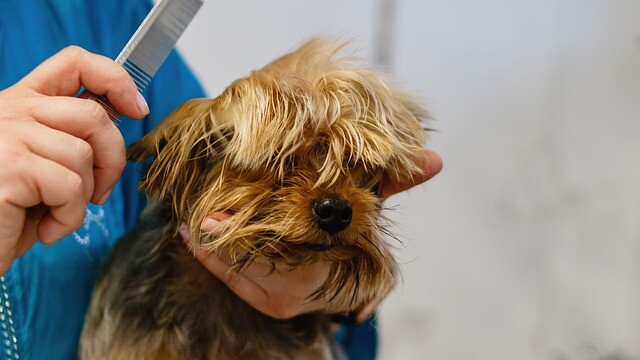Seborrhea in Dogs: Causes, Symptoms & Treatment
28.02.2022.
Skin issues are not only reserved for humans. Unfortunately, our beloved dogs can have them as well. One of the possible skin issues our dogs can have is seborrhea. It can be pretty uncomfortable, and if you are worried about your dog, you should learn what seborrhea is, how it happens, and what the available treatments are. Here’s what you should know about seborrhea in dogs.
What is seborrhea in dogs?
Seborrhea, or seborrheic dermatitis, is a skin disorder. More precisely, it is a disorder where sebaceous glands produce too much sebum. This disorder mainly affects the back, flanks, and face. It is most severe in the skin folds of the dog. There are two types of seborrhea in dogs;
- Seborrhea sicca - Seborrhea sicca is dry seborrhea, meaning it causes dry skin.
- Seborrhea oleosa - Seborrhea oleosa is oily seborrhea, meaning it causes oily skin.

Dogs with this skin disorder usually have a combination of dry and oily seborrhea.
RELATED: 10 Best Home Remedies for Itchy Skin in Dogs
What causes seborrhea in dogs?
All types of seborrhea in dogs are caused by the malfunctioning of the sebaceous glands. However, vets divided this condition into two types - primary and secondary.
Primary seborrhea
Primary seborrhea in dogs is inherited, which means there is a genetic component to the disorder. It is most commonly seen in Westies, Basset Hounds, and Cocker Spaniels.

Secondary seborrhea
Secondary seborrhea is more common among dogs. It usually happens as a result of an underlying health issue. However, some cases don’t have a clear cause. In those cases, this type of seborrhea is called idiopathic seborrhea. In other cases, secondary seborrhea is caused by;
- Allergies
- Poor diet (not enough omega fatty acids)
- Thyroid issues (hypothyroidism or hyperthyroidism)
- Cushing’s disease
- Fungal infections
- Obesity
- Environmental causes (humidity changes or temperature)
- Inability to groom itself (musculoskeletal diseases or pain)
RELATED: Hot Spots on Dogs and What to Do About Them
How can I know if my dog has seborrhea?
Seborrhea in dogs is not that common. Dogs more often develop other types of dermatitis. That means dog owners will notice something weird is going on with their dog, but they might not think of seborrhea immediately. Most of us will see things like oily or dry patches of skin, hair loss, redness, or intense itching. That’s when most dog owners call their vets and book an appointment. The safest way to get a correct seborrhea diagnosis is to get it from your vet.

Symptoms of seborrhea in dogs
As you can imagine, skin issues will cause specific problems. Those problems are actually the disease’s symptoms. They are very easy to notice because they usually look worse than they actually are. The most common symptoms of seborrhea in dogs are;
- Dog dandruff
- Specific odor (this odor is connected to seborrhea)
- Red and inflamed skin areas
- Dry or oily lesions (depending on the type of seborrhea)
- Symptoms are worse in areas with skin wrinkles
Some cases will include all these symptoms, and some might only include one. Cases can vary in severity, but that doesn’t mean the dog doesn’t have to receive treatment.
RELATED: Is Your Dog Losing Hair? Here Are Some Common Causes
How is seborrhea diagnosed?
The first thing your vet will look at is the clinical signs the dog is exhibiting. That will usually be more than enough to diagnose seborrhea. However, the vet will need to determine the exact cause of seborrhea. Without the precise cause, treatment will be pretty hard to determine. Here are some of the tests that might help the vet determine the precise cause of seborrhea;
- Skin cytology and biopsy - These tests will show the vet if there are any inflammatory cells, yeast, or bacteria present.
- Skin scrapings - Skin scrapings can help vets determine if seborrhea is caused by parasites. In many cases, mites are the culprit.
- Skin culture - This is usually a test that vets need to determine the exact species of bacteria or yeast causing issues. It can help them decide which type of antibiotic or antifungal medication is required.
- Hormone tests - Hormone tests can reveal issues like Cushing’s disease or hypothyroidism.
How is seborrhea in dogs treated?
The exact treatment will depend on the cause. For example, treating seborrhea with antibiotics, but the problem is not caused by bacteria, makes no sense. When the underlying problem is uncovered, the vet will prescribe specific medications to treat that. Unfortunately, idiopathic seborrhea has no treatment. Instead, the vet might recommend you try different things. Some of those things are;
- Prednisone (corticosteroid)
- Shampoos for seborrhea
- Supplements that include loads of omega fatty acids
- Oral cyclosporine (Atopica)
- Retinoids
- Antibiotics for secondary infections
What is the prognosis?
The prognosis for dogs with an underlying condition that is uncovered and treated is generally pretty good. However, the prognosis will depend on the severity of seborrhea the dog developed. Your vet will know how to assess the situation and tell you the best treatment for your dog specifically.
World Dog Finder team







Share